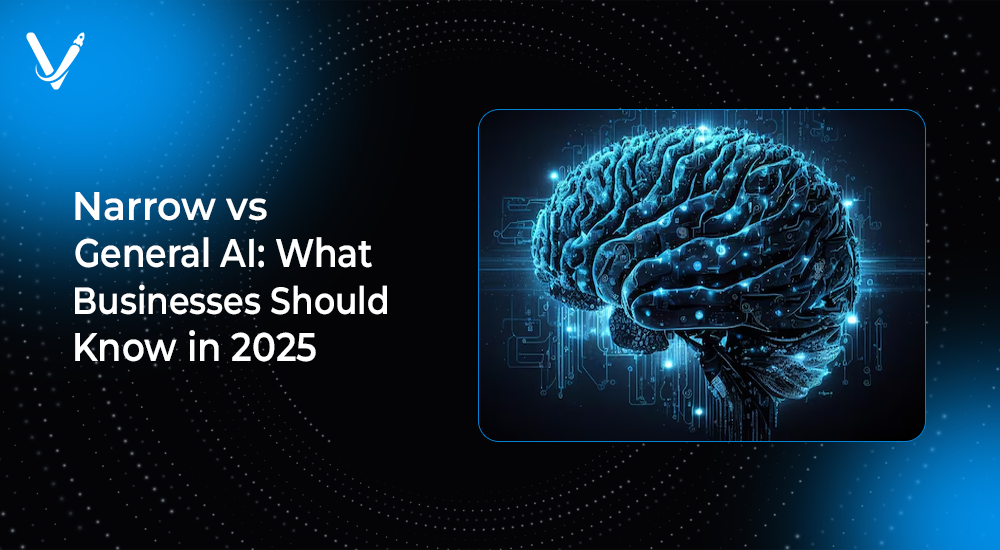Narrow vs General AI: What Businesses Should Know in 2025


- Oct 27, 2025
Key Takeaways
Artificial Intelligence has rapidly evolved into the backbone of the digital business era. As enterprises adopt automation, predictive analytics, and generative tools to transform operations, a key question dominates boardroom discussions: Are we ready for General AI, or are we still living in the era of Narrow AI?
In 2025, this debate is not just theoretical—it’s strategic. The distinction between Narrow AI and General AI shapes how companies invest, innovate, and compete. Narrow AI powers everything from customer chatbots and recommendation engines to fraud detection systems and predictive maintenance platforms. Meanwhile, General AI—often envisioned as the “thinking” counterpart capable of reasoning across domains—still lingers on the horizon, evolving quietly in research labs and deep learning experiments.
This article dives deep into the differences between Narrow and General AI, their business implications, real-world use cases, and what every organization should understand before stepping into the next wave of AI-driven transformation. We’ll uncover where we are, where we’re heading, and how to strategically position your business for sustainable AI success.
Before exploring their business relevance, it’s essential to clarify the conceptual difference between Narrow AI and General AI.
Narrow AI, also known as Weak AI, refers to systems designed to perform specific tasks with remarkable precision. It operates within defined boundaries, focusing on optimizing one function—like voice recognition, text generation, or visual object detection. Siri, ChatGPT, Tesla’s autopilot, and recommendation algorithms on Netflix or Spotify all fall under this category. They are trained on massive data sets but lack independent reasoning or self-awareness.
General AI, or Strong AI, on the other hand, is the aspirational goal of replicating human-like intelligence. It’s the stage where machines not only perform tasks but also understand context, adapt autonomously, and learn across domains. A General AI could diagnose a patient, write code, predict stock trends, and negotiate business contracts—all using its own comprehension of the world.
While Narrow AI thrives in real-world deployment, General AI is still largely conceptual. Yet, the rapid advancements in multimodal models, reinforcement learning, and neural reasoning architectures are pushing the boundaries of what’s possible.
For businesses, understanding this divide determines how they allocate AI budgets, select vendors, and plan scalability in 2025.
Narrow AI is not limited—it’s laser-focused. Its strength lies in doing one thing extraordinarily well, and that’s why it dominates commercial applications.
Businesses across industries rely on Narrow AI to optimize workflows, predict consumer behavior, and personalize engagement. Instead of replicating human thinking, Narrow AI enhances human capabilities by providing data-driven insights and automating repetitive tasks.
AI-Powered Customer Support:
Chatbots powered by Natural Language Processing (NLP) are now capable of resolving most customer queries instantly. Platforms like Intercom, Drift, and Zendesk use Narrow AI to reduce human workload while maintaining conversational tone and accuracy.
Predictive Maintenance in Manufacturing:
Factories use Narrow AI to detect machine anomalies before they occur. Sensors feed real-time data into predictive models that alert technicians about potential breakdowns, significantly reducing downtime.
Personalized Marketing and Recommendation Engines:
E-commerce giants deploy AI models that analyze user behavior and preferences to recommend relevant products. This personalization increases engagement and conversion rates.
Fraud Detection in Finance:
Banks and fintech companies use AI to flag unusual patterns, preventing fraudulent transactions by analyzing behavioral data in milliseconds.
Healthcare Diagnostics:
AI algorithms identify patterns in medical imaging or pathology data that might escape human eyes, accelerating diagnosis and improving treatment accuracy.
These use cases highlight that Narrow AI doesn’t need general intelligence to drive value—it thrives on domain-specific mastery.
While Narrow AI excels at specialization, General AI aims to revolutionize intelligence itself. It envisions a machine that can think, reason, and adapt across contexts just like a human—an entity capable of performing any intellectual task with minimal supervision.
In 2025, research into General AI is accelerating due to breakthroughs in transformer architectures, multimodal learning, and self-reflective agents. These systems combine vision, language, and reasoning in ways that begin to mimic abstract human cognition.
Transfer Learning Beyond Boundaries:
General AI aspires to apply knowledge learned in one domain to another—like using lessons from chess strategy to optimize logistics operations.
Contextual Adaptability:
Unlike task-specific models, General AI understands nuance and adapts dynamically. It can interpret tone, ethics, or cultural variations in decision-making.
Cognitive Reasoning:
Strong AI aims to interpret cause and effect, not just correlations. It understands “why” something happens and can adjust strategies in real time.
Emotional and Ethical Intelligence:
A truly General AI system would navigate empathy, fairness, and moral reasoning, making decisions that consider human impact alongside data.
Despite this vision, practical deployment remains years away. The computational, ethical, and regulatory challenges are massive. But businesses must keep a close eye on these advancements because the shift from task-based to autonomous cognitive systems could redefine every industry.
| Aspect | Narrow AI | General AI |
| Focus | Task-specific intelligence | Multi-domain, human-like cognition |
| Learning Type | Supervised or reinforcement learning for specific use | Self-learning across tasks and contexts |
| Adaptability | Limited to trained parameters | Adapts autonomously to new domains |
| Current Status (2025) | Commercially deployed across sectors | Experimental and research-based |
| Human Oversight | Required for goal definition and correction | Minimal, intended for autonomous decision-making |
| Examples | Chatbots, facial recognition, predictive analytics | Hypothetical AGI models, advanced self-learning agents |
This table illustrates why Narrow AI remains the cornerstone of enterprise applications, while General AI continues to be the holy grail of research.
Most enterprises are not chasing artificial consciousness—they are pursuing measurable efficiency. Narrow AI systems deliver that through data optimization, automation, and predictive precision.
Narrow AI models are easier to train, deploy, and scale across departments. A marketing firm can implement AI-driven ad optimization today and see measurable results within weeks. General AI, in contrast, demands significant computational and financial resources without immediate ROI.
Narrow AI operates within predictable parameters. Its actions can be monitored and audited, which aligns with data compliance laws like GDPR and India’s Digital Personal Data Protection Act. General AI’s autonomy introduces unpredictable risks that current governance frameworks cannot yet manage.
Most enterprise systems—CRMs, ERPs, and analytics platforms—already support Narrow AI integration. Companies like Salesforce Einstein, SAP Leonardo, and Microsoft Copilot illustrate how seamlessly AI embeds into business workflows.
Narrow AI complements human expertise. A data analyst can use AI tools to uncover insights faster, or a healthcare professional can interpret AI-driven diagnostics more accurately. Instead of replacing jobs, these systems enhance productivity and decision-making.
Even though General AI isn’t commercially viable yet, its potential captures the imagination of innovators and investors. Businesses envision AGI as a tool that could reshape industries by combining creativity, reasoning, and adaptability.
Imagine a digital strategist that not only analyzes campaigns but also understands your brand ethos, customer psychology, and market context—then autonomously crafts campaigns that resonate emotionally and ethically. That’s the General AI dream.
Cross-Functional Adaptability:
A General AI system could operate across departments—handling finance, HR, marketing, and logistics without reprogramming.
Continuous Learning:
It wouldn’t just process data but evolve with every new experience, learning from its environment like a human employee.
Strategic Decision-Making:
With comprehensive contextual understanding, General AI could provide scenario planning, risk analysis, and predictive forecasting at unparalleled accuracy.
True Personalization:
Instead of recommending what you liked before, it would predict what you might want next, blending intuition with analytics.
While these advantages sound futuristic, the foundations are being laid today through large language models (LLMs), autonomous agents, and multimodal AI systems. Businesses experimenting in these domains are effectively preparing for the AGI era.
The transition toward more adaptive, intelligent systems doesn’t happen overnight. Businesses must adopt a phased strategy that balances innovation with stability.
AI success begins with understanding. Equip teams with the knowledge to interpret AI insights, -++identify limitations, and collaborate effectively with intelligent systems.
Instead of chasing AGI, companies should focus on Narrow AI solutions that solve real problems—predictive analytics, automated support, demand forecasting, or personalized recommendations.
Collaborate with AI solution providers like Vasundhara Infotech, who specialize in tailoring advanced AI tools for specific business needs. Expert partnerships ensure faster deployment, higher ROI, and long-term scalability.
Create AI governance policies that define accountability, transparency, and data handling standards. Ethics must be built into the AI lifecycle, not added as an afterthought.
Even if General AI isn’t here yet, staying updated on emerging technologies like agentic AI, reasoning models, and quantum neural networks keeps your organization prepared for the next paradigm shift.
According to industry surveys and global AI adoption reports, over 75% of enterprises use at least one Narrow AI solution in production. Key trends include:
Generative AI Integration:
Businesses deploy generative models for marketing content, design ideation, and code generation—accelerating workflows and creativity.
AI in Decision Intelligence:
Decision-making systems powered by AI are helping managers optimize pricing, inventory, and workforce planning.
Predictive Analytics for Market Insights:
Retail, healthcare, and logistics industries rely heavily on AI-powered forecasting to anticipate consumer and operational trends.
Conversational and Emotional AI:
Customer service tools now incorporate emotional recognition to personalize tone and empathy in digital interactions.
Autonomous Systems in Mobility and Robotics:
Smart factories and delivery fleets are integrating AI-driven robotic automation to enhance precision and safety.
These real-world applications reinforce the message: the AI revolution is already here—it’s just not General AI yet.
To thrive in this AI-driven ecosystem, organizations need a clear adoption roadmap aligned with their long-term goals.
Identify business pain points that AI can address. Evaluate feasibility, expected ROI, and ethical implications.
High-quality, structured data fuels accurate AI outcomes. Invest in robust data pipelines, storage, and governance mechanisms.
Work with AI experts to choose models tailored to your domain—be it NLP, computer vision, or predictive analytics.
Conduct pilot programs, monitor results, and scale gradually. Continuous evaluation ensures reliability and compliance.
AI is not static. Regular updates, retraining, and fine-tuning are essential to maintain performance and accuracy.
This strategic approach ensures sustainable AI growth while minimizing risks.
In the next few years, we’ll likely witness the rise of proto-General AI systems—AI models capable of reasoning across limited domains with human-like intuition. These systems will bridge the gap between Narrow AI and true AGI.
Technologies like Large Language Models (LLMs), Reinforcement Learning with Human Feedback (RLHF), and Neural Symbolic Reasoning are already transforming how AI understands and interacts with the world.
But as we advance, the focus must remain on human-centered AI—solutions that amplify human creativity, empathy, and ethics rather than replace them.
Businesses that prepare for this evolution now will not only survive but lead the next decade of intelligent transformation.
In 2025, Artificial Intelligence stands at a defining crossroads. Narrow AI empowers businesses today, driving measurable improvements in efficiency, accuracy, and customer engagement. General AI promises the future, offering a vision of autonomous intelligence capable of cross-domain mastery.
For businesses, the key is to leverage the proven power of Narrow AI while staying adaptable for the advancements ahead. Every investment, integration, and AI experiment should serve the ultimate goal—building smarter, faster, and more ethical organizations.
At Vasundhara Infotech+*-, we help enterprises harness AI technologies that align with their strategic objectives. From intelligent automation and RAG pipeline solutions to agentic AI frameworks, we design systems that scale with innovation and reliability.
Let’s shape your AI future—today.
Copyright © 2025 Vasundhara Infotech. All Rights Reserved.
